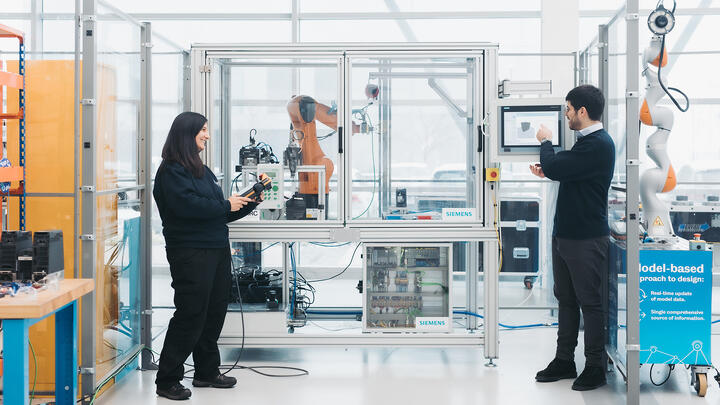Engineers deliver first-of-its-kind automated disassembly system
How does it link to the digital thread concept?
The project proved the feasibility of an automated disassembly system to reuse and recycle legacy components during a product’s lifecycle.
The high variability of what might come through a disassembly cell would traditionally require a lot of robot programming. The digital thread and specifically model-based systems engineering (MBSE) would help automatically programme the robots for each different drive unit and support competitiveness of the process.
A digital thread can also help to enable accurate carbon accounting for sustainability credentials, alongside assurance for traceability and wider transparency - and could offer similar benefits to this project to aid sustainability goals and share results with a key external stakeholder.
Challenge
To produce a robust data-driven automated disassembly demonstrator for components that were never designed with this type of disassembly in mind.
Background
Working closely with AMRC Tier 1 member and research partner Siemens, research engineers were tasked with helping to drive forward the company’s sustainability goals for its digital industries motion control products.
This collaborative project identified opportunities to recover and sort legacy components during their product life cycles, where they hold greater value for repair, reuse, and recycling. There was also the requirement for the demonstrator to accommodate a range of Siemens products, meaning it had to be flexible in its product fixturing solutions as well as common tooling, and operations to perform the automated disassembly.
Siemens is a leading technology company focused on industry, infrastructure, transport and healthcare. From more resource-efficient factories, resilient supply chains and smarter buildings and grids, to cleaner and more comfortable transportation as well as advanced healthcare, the company creates technology with purpose adding real value for customers.
By combining the real and the digital worlds, Siemens empowers its customers to transform their industries and markets, helping them to transform the everyday for billions of people.
Innovation
As part of the creation of a Siemens Disassembly cell, the team at the AMRC analysed the existing product range under their drive technology motor inverters to understand the feasible orders and methods of disassembly to component level. The team also down selected the exact product (SINAMICS G120C frame size FSAA) together, within a workshop to use for the automated disassembly demonstrator and also implemented tooling and fixturing solutions for multiple product families (FSA, FSAA & FSB).
Research was undertaken on automated disassembly techniques and tooling, used in industry, to achieve an efficient disassembly process and how best to adapt it for Siemens products.
Siemens arranged a visit to their assembly production line that helped drive the AMRC’s mechanical design as well as giving the opportunity to assess whether assembly tooling and methods could be re-used for the disassembly. Siemens NX, an advanced high-end CAD and CAM software was used to design the tooling, fixturing as well the disassembly cell itself.
The solution was then further developed, and implemented to create a reconfigurable, automated disassembly cell that could disassemble different product families. The team followed a design process that promotes agile manufacturing by completing fixturing and disassembly experiments ahead of the design being finalised.
A flexible fixturing system, which can secure multiple products using a single fixture with independently actuated pneumatic clamps, was also designed to secure the different products - and a range of robot end-effector tooling was designed to conduct the dexterous disassembly tasks.
The AMRC used as many components from previous projects as possible. Most components in the final cell were sourced this way and the approach kept final costs for the cell in budget and gave a second life to products that didn’t have an allocated project.
Result
The demonstrator successfully proved the feasibility of an automated disassembly system that can inspect, dismantle and sort the sub-components of electronic devices for reuse and recycling – helping to close the loop of circular manufacturing.
As a result of using a combination of the AMRC’s innovative methods and Siemens’ technologies and know-how, engineers delivered a first-of-its-kind connected disassembly demonstrator for Siemens Motion Control products.
Impact
The project has been fundamental for the AMRC and by extension the University of Sheffield’s vision and strategic plan to support sustainable manufacturing, improve relationships with Industry and innovate.
The outcome of delivering this project also has the potential to significantly drive design for disassembly and automated disassembly methods to reduce waste, avoid downcycling and positively impact product sustainability throughout Siemens motion control product portfolio.
An additional output created also two European Union protected patent applications for Siemens, for aspects of the generated IP.

